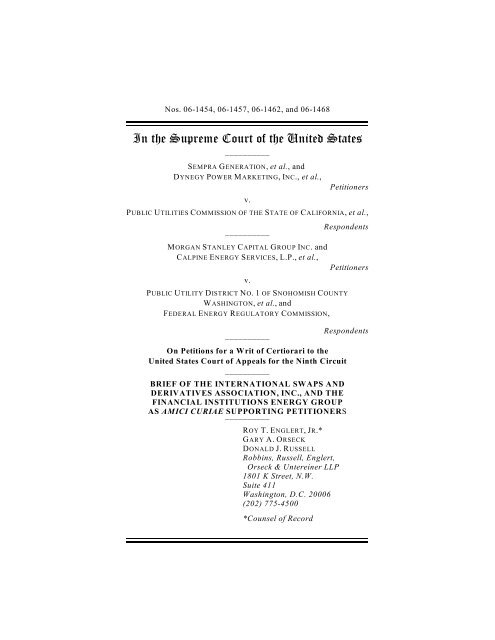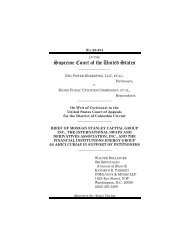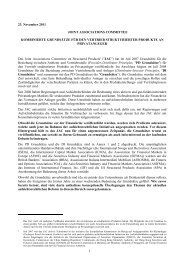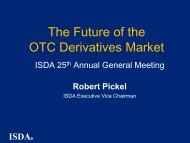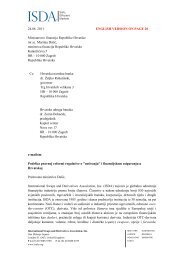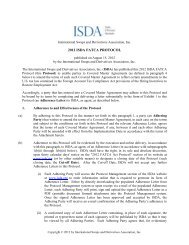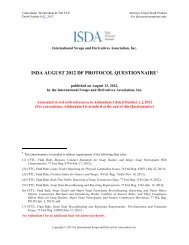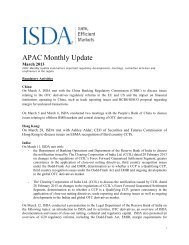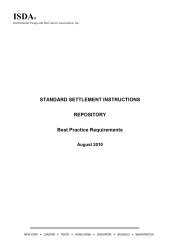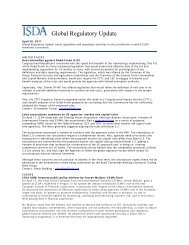Petition for a Writ of Certiorari - Snohomish. - ISDA
Petition for a Writ of Certiorari - Snohomish. - ISDA
Petition for a Writ of Certiorari - Snohomish. - ISDA
Create successful ePaper yourself
Turn your PDF publications into a flip-book with our unique Google optimized e-Paper software.
iiiTABLE OF AUTHORITIES—continuedPage(s)Electric Power Annual, Energy In<strong>for</strong>mationAdministration (Nov. 9, 2006), available at http://www.eia.doe.gov/cneaf/electricity/epa/epa_sum.html.. . 6Energy In<strong>for</strong>mation Administration, Revenue from RetailSales <strong>of</strong> Electricity To Ultimate Customers by Sector,by Provider (Oct. 4, 2006), available at http://www.eia.doe.gov/cneaf/electricity/epa/epat7p3.html. . . 5Michael S. Haigh, Jeffrey H. Harris, James A. Overdahl& Michael A. Robe, Market Growth, TraderParticipation and Pricing in Energy Futures Markets(Feb. 7, 2007), available at http://web.uvic.ca/econ/robe.pdf.................................. 7Michael S. Haigh, Jana Hranaiova & James A. Overdahl,Price Dynamics, Price Discovery and Large FuturesTrader Interactions in the Energy Complex (April 28,2005), available at http://cftc.gov/files/opa/press05/opacftc-managed-money-trader-study.pdf. . . . . . . . . . . . 7Testimony <strong>of</strong> Michael R. Niggli, Exh. SER-1, FERCDocket No. EL02-60-003 (filed Oct. 24, 2002).. . . . . . 17
2ly settled derivative transactions designed to hedge certaincounterparty risk or to establish a proprietary position in themarket, arrangers <strong>of</strong> loan facilities, and underwriters <strong>of</strong> debt andequity securities.Members <strong>of</strong> <strong>ISDA</strong> and FIEG are substantial participants inthe market <strong>for</strong> wholesale electric power sales. Some <strong>of</strong> thosemembers own interests in companies that produce electric powerand sell it in the wholesale market. Some own interests incompanies that purchase electric power in the wholesale marketand distribute it to end users. And some are not involved ineither the production or the retail distribution <strong>of</strong> electric power,but participate as traders that buy and sell power in transactionswith producers, retail distributors, and other traders. <strong>ISDA</strong> andFIEG do not have an institutional interest to promote legal rulesthat systematically favor either buyers or sellers <strong>of</strong> electric power.Rather, amici seek to promote legal rules necessary to ensurea vibrant and efficient market <strong>for</strong> electric power, which willbenefit all market participants – both buyers and sellers – and,indirectly, end users <strong>of</strong> electricity, whose interests are served bythe efficient production and distribution <strong>of</strong> electric power.This interest in a vibrant and efficient market is threatenedby the Ninth Circuit’s decisions in these cases. Clear, stable, anden<strong>for</strong>ceable rules governing contracts are essential <strong>for</strong> any marketto function effectively, and are especially important in themarket <strong>for</strong> electric power, which depends on long-term investmentsand contractual sales involving hundreds <strong>of</strong> billions <strong>of</strong>dollars every year. For more than half a century, decisions <strong>of</strong>this Court have protected the legitimate economic expectations<strong>of</strong> participants in this market, by making clear that, when partieschoose to enter into a contract to buy or sell power, their agreementwill be en<strong>for</strong>ced even if, in hindsight, the agreementturned out to be unfavorable to one or more contracting parties.The Ninth Circuit’s decisions are fundamentally at odds withthat principle. Because <strong>of</strong> their members’ unique role in thismarket, amici are well positioned to explain why the Ninth Circuit’sdecisions, if allowed to stand, will lead to market dys-
3function that will impose enormous costs on the Americanpublic.SUMMARY OF ARGUMENTUnless corrected, the Ninth Circuit’s decisions will causeserious harm to the market <strong>for</strong> wholesale electric power. Thatmarket is extraordinarily important to the Nation’s economy.End users spend about $300 billion annually to purchase electricity,and much <strong>of</strong> that power is purchased in a vibrant wholesalemarket that has developed over the past decade. In addition toproducers and retail distributors <strong>of</strong> power, participants in thiswholesale market include many firms that principally operate astraders. Their presence has enhanced market liquidity and transparency,and has permitted producers and distributors to reducetheir exposure to financial risk by using contractual arrangementsthat shift risk to traders with greater expertise in riskmanagement.It is essential <strong>for</strong> those traders, and <strong>for</strong> other market participants,to be able to rely on the integrity and en<strong>for</strong>ceability <strong>of</strong>contracts. That need has been served <strong>for</strong> more than half a centuryby the Mobile-Sierra doctrine, which prevents the regulatoryabrogation <strong>of</strong> contracts in all but the most extraordinarycircumstances. The Ninth Circuit’s decisions, while purportingto apply that doctrine, effectively overrule it.The Ninth Circuit held that the Mobile-Sierra doctrinecannot be invoked unless the Federal Energy RegulatoryCommission (FERC) had an initial opportunity to conduct aplenary “just and reasonable” review <strong>of</strong> contract rates and toreview the market conditions under which the contract wasnegotiated – and to conduct such a review not just when thecontract is executed, but years later, with the benefit <strong>of</strong> hindsight.The Ninth Circuit then held that buyers may escape theircontractual obligations and obtain rate reductions if, in retrospect,their contract was negotiated in a “dysfunctional” marketand established rates that proved to be outside a zone <strong>of</strong> reasonableness.These standards dramatically undermine sellers’ability to rely on buyers’ contractual commitments.
4Only this Court can prevent the harm threatened by theNinth Circuit’s errors. For so long as the decisions remain onthe books as valid precedents, they create a risk that buyers willbe able to escape their contractual commitments – if not thesecommitments by these buyers, perhaps other commitments byother buyers in the future. Regardless <strong>of</strong> FERC’s eventualdecisions about the specific contracts involved here, that riskwill remain. Among other things, the Ninth Circuit’s newstandards will discourage the use <strong>of</strong> long-term contracts thatprovide important benefits – facilitating investment, mitigatingfinancial risks, and reducing market volatility. Those standardswill also discourage sellers <strong>of</strong> power from increasing supplywhen it is most needed, i.e., when prices spike upwards inresponse to a large imbalance between demand and supply. Thatis the circumstance in which sellers will least be able to rely onbuyers’ contractual commitments, because that circumstance ismost likely to be characterized, in retrospect, as a market “dysfunction.”The standards will vastly increase the likelihood andthe cost <strong>of</strong> litigation, because the en<strong>for</strong>ceability <strong>of</strong> contracts willno longer depend on the straight<strong>for</strong>ward question whether acontract is valid but will rest, instead, on the amorphousquestion whether the market was “dysfunctional.” In these andother respects, the Ninth Circuit’s decisions, unless corrected,will raise the costs and reduce the financial rewards tocompanies that produce electric power and trade in thewholesale power market. Regardless <strong>of</strong> the outcome <strong>of</strong> thespecific disputes in these cases, the Ninth Circuit decisionsthreaten serious harm to the efficient operation <strong>of</strong> that marketand, ultimately, to consumers.ARGUMENTI. Unless Corrected, The Ninth Circuit’s Interference WithThe En<strong>for</strong>cement Of Contracts Will Undermine AnExtraordinarily Important Sector Of The EconomyThe electric power industry affects daily life and the Nation’seconomic well-being to a degree that is matched by fewother industries. End users spend about $300 billion annually to
52purchase electricity in the United States. Electric power isessential to virtually every productive activity in the Nation’seconomy, and the generation and consumption <strong>of</strong> electricity isstrongly correlated with the overall level <strong>of</strong> economic activity. 3Today, companies that distribute electricity to end users buythe overwhelming proportion <strong>of</strong> that power in wholesale transactions.This fact reflects fundamental changes in the regulationand structure <strong>of</strong> the industry over the past decade. For most <strong>of</strong>the twentieth century, the industry was dominated by verticallyintegrated utilities that generated electricity, transmitted it tolocal distribution networks, and provided retail service to endusers, subject to cost-based rate regulation. Beginning in themid-1990s, FERC (regulating wholesale power sales) and manyStates (regulating retail sales) shifted from cost-based rate regulationto a market-based regime. To ensure competition inwholesale sales, high-voltage transmission lines (which carryelectricity from the point <strong>of</strong> generation to local distribution networks)were subjected to “open access” requirements, permittingmany different producers <strong>of</strong> power to compete to sell powerto individual retail distribution companies. In addition, manyvertically integrated utilities were divided into separate generationand distribution companies. See generally 06-1457 Pet.App. 11a-22a.The result <strong>of</strong> these changes was “a sharp increase in wholesalepower sales – subject to FERC’s exclusive jurisdiction – asutilities shopped among suppliers.” 06-1457 Pet. App. 21a.“[T]he breakup <strong>of</strong> vertically integrated utilities created the need<strong>for</strong> many more wholesale transactions.” Ibid. Three trillion 661billion kilowatt-hours <strong>of</strong> electricity were sold at retail in 2005;2Energy In<strong>for</strong>mation Administration, Revenue from Retail Sales <strong>of</strong>Electricity To Ultimate Customers by Sector, by Provider (Oct. 4, 2006),available at http://www.eia.doe.gov/cneaf/electricity/epa/epat7p3.html.3Edison Electric Institute, U.S. Economic Growth Is Linked ToElectricity Growth (2007), available at http://www.eei.org/industry_issues/industry_overview_and_statistics/realgdp.pdf.
6nearly 90% <strong>of</strong> that amount (3,246 billion kilowatt-hours) waspurchased by the companies engaged in retail distribution. 4The wholesale market that has developed is broad, diverse,complex, and very, very large. Power is sold in many differentways. Some sales result from bilateral negotiations betweenindividual buyers and sellers; some are effected through acompetitive bidding process; some are conducted on organizedexchanges. Power is sold in spot markets, in which buyers canacquire power to supply immediate, short-term needs. It is alsosold through contracts that provide <strong>for</strong> the delivery <strong>of</strong> powerover longer time periods, sometimes covering many years.Participation in the wholesale market has expanded farbeyond those companies that produce or distribute electricpower. The roster <strong>of</strong> electric power marketers now includesmany large traders, including members <strong>of</strong> <strong>ISDA</strong> and FIEG.Some <strong>of</strong> these firms own interests in power producers and/ordistributors; some do not. Regardless, the principal marketactivity <strong>of</strong> many <strong>of</strong> these traders (including those that owninterests in producers or distribution businesses and those thatdo not) consists <strong>of</strong> contracting with power producers, distributioncompanies, and other traders to buy or sell wholesale powerthat will ultimately be produced or distributed by others.In an important way, the firms that participate in the marketprincipally as traders are unlike power producers selling theirown output, or distribution companies purchasing power <strong>for</strong> resaleto end users. Traders tend, over the long term, to be neithernet sellers nor net purchasers <strong>of</strong> power. Traders generally seekto purchase only the power they can sell, and to sell only whatthey can purchase. Thus, they have no vested interest in rulesthat systematically favor sellers or buyers. Their interest, instead,is in rules that enhance the efficient operation <strong>of</strong> themarket, <strong>for</strong> the benefit <strong>of</strong> both buyers and sellers.4Electric Power Annual, Energy In<strong>for</strong>mation Administration (Nov.9, 2006), available at http://www.eia.doe.gov/cneaf/electricity/epa/epa_sum.html.
9promoted the Act’s purposes, as well. “[P]reserving the integrity<strong>of</strong> contracts * * * permits the stability <strong>of</strong> supply arrangementswhich all agree is essential.” Id. at 344. Parties could not beexpected to make “substantial investments * * * without longtermcommitments,” and such commitments are impossible if“supply contracts are subject to unilateral change.” Ibid.The Court followed and extended the Mobile decision inanother unanimous decision on the same day. Federal PowerComm’n v. Sierra Pacific Power Co., 350 U.S. 348 (1956),arose under the Federal Power Act, the relevant provisions <strong>of</strong>which were “substantially identical” to the provisions <strong>of</strong> theNatural Gas Act that were construed in Mobile. Id. at 353.Sierra followed Mobile in holding that a party could not unilaterallymodify the rate established in a long-term contract by filingnew rates with the Commission. Sierra also addressed aquestion not presented in Mobile: In what circumstances couldthe Commission determine that contract rates were unlawful,and prescribe modifications to those rates to remedy the perceivedunlawfulness? Sierra held that the contractual rate couldbe set aside only if it would “adversely affect the public interest– as where it might impair the financial ability <strong>of</strong> the publicutility to continue its service, cast upon other consumers an excessiveburden, or be unduly discriminatory.” Id. at 355. This“public interest” standard is not satisfied merely because therate prescribed by the contract was a rate that the Commission,itself, could not have imposed under a “just and reasonable”standard. “[W]hile it may be that the Commission may not normallyimpose upon a public utility a rate which would produceless than a fair return, it does not follow that the public utilitymay not itself agree by contract to a rate af<strong>for</strong>ding less than afair return or that, if it does so, it is entitled to be relieved <strong>of</strong> itsimprovident bargain.” Ibid. “[A] contract may not be said to beeither ‘unjust’ or ‘unreasonable’ simply because it is unpr<strong>of</strong>itableto the public utility.” Ibid. In 2002, the Court explained,again, one <strong>of</strong> the reasons <strong>for</strong> that conclusion. “In wholesale markets,the party charging the rate and the party charged were<strong>of</strong>ten sophisticated businesses enjoying presumptively equal
12review must permit consideration <strong>of</strong> the “propriety <strong>of</strong> thecontract’s <strong>for</strong>mation,” including whether the contract negotiations“occurred in a functional marketplace.” Ibid. And, even ifcontract rates are subject to that initial review, there is still noguarantee that the rates will be protected by the Mobile-Sierradoctrine if challenged at some later time. The Ninth Circuitexplicitly held that Mobile-Sierra did not require en<strong>for</strong>cement<strong>of</strong> one <strong>of</strong> the contracts involved here because, when the contractwas negotiated and filed with the Commission, “the full scale <strong>of</strong>* * * market dysfunction was not nearly as fully known as it istoday.” 06-1454 Pet. App. 11a. It held, furthermore, that buyerscould seek unilateral modifications to rates even if their contractwaived the right to do so. 06-1457 Pet. App. 42a-46a.After creating those prerequisites <strong>for</strong> the application <strong>of</strong>Mobile-Sierra principles, the Ninth Circuit then gutted thecontent <strong>of</strong> those principles. It held that sellers’ ability to escapecontractual obligations continues to be governed by the Sierrastandard – whether the contract will “adversely affect the publicinterest – as where it might impair the financial ability <strong>of</strong> thepublic utility to continue its service, cast upon other consumersan excessive burden, or be unduly discriminatory.” 350 U.S. at355. Buyers, are the other hand, can escape contractual obligations“if a challenged contract imposes any significant cost onultimate customers because <strong>of</strong> a wholesale rate too high to bewithin a zone <strong>of</strong> reasonableness.” 06-1457 Pet. App. 63a. Thestandard, in other words, is whether the electric bills <strong>of</strong> consumerswould be “higher than they would otherwise have been hadthe challenged contracts called <strong>for</strong> rates within the just and reasonablerange.” Id. at 64a.These newly created standards drastically underminesellers’ ability to rely on buyers’ contractual commitments. Thestandards make it impossible <strong>for</strong> sellers to control or confidentlypredict whether a contract will be en<strong>for</strong>ceable, because a contractmay be set aside <strong>for</strong> reasons entirely unrelated to the behavior<strong>of</strong> the contracting parties. Here, <strong>for</strong> example, there is noevidence that petitioners engaged in any market manipulation
13that affected the contracts. See, e.g., 06-1454 Pet. App. 118a.Similarly, there is no evidence <strong>of</strong> unfairness, bad faith, or duressby petitioners in the contract negotiations. 06-1457 Pet.App. 33a. And there is no evidence that any <strong>of</strong> these petitionershad, or exercised, market power. For each <strong>of</strong> the contracts atissue, the buyer obtained multiple competing <strong>of</strong>fers, and enteredthe contract voluntarily because the terms <strong>of</strong> the contractseemed advantageous at the time. See, e.g., 06-1454 Pet.App. 111a-119a (describing CDWR contract negotiations).None <strong>of</strong> this matters under the Ninth Circuit’s standard,which permits contracts to be set aside if the market is subsequentlydeemed to be “dysfunctional.” Here, the “dysfunction”took the <strong>for</strong>m <strong>of</strong> a dramatic increase in prices in the Cali<strong>for</strong>niaspot market, which was attributed to (1) unusually high demand<strong>for</strong> electricity, combined with a scarcity <strong>of</strong> generation capacity,(2) buyers’ excessive reliance on spot-market purchases, due toa confluence <strong>of</strong> regulatory policies, and (3) illegal manipulation<strong>of</strong> spot-market prices by other participants in that market. 06-1457 Pet. App. 23a-25a. These were market conditions, however,that affected both buyers and sellers, and that (aside fromthe illegal actors) neither buyers nor sellers could control.As applied by the Ninth Circuit here, the standard <strong>of</strong> market“dysfunction” makes no sense. In a properly functioning market,prices are supposed to rise and fall in response to changes inmarket conditions, including changes in supply and demand,and changes in prices in adjacent markets (whatever the cause).Such price movements indicate that the market is working as itshould, not that it is dysfunctional. That is especially true whenthere is no indication – as there is no indication here – that thecontracting parties behaved improperly or that the market wasnot workably competitive at all times.The Ninth Circuit undermined the sanctity <strong>of</strong> contracts inyet another way by allowing – indeed, seemingly requiring – theuse <strong>of</strong> hindsight to determine whether a contract was negotiatedin a “dysfunctional” market, rather than relying on the in<strong>for</strong>mationthat was available when the contract was negotiated. That
14approach defeats one <strong>of</strong> the principal functions <strong>of</strong> contracts.Long-term contracts always involve uncertainty about whethermarket prices will remain at current levels, will increase, or willdecline during the term <strong>of</strong> the contract, and a corresponding riskthat the contract price will turn out to be a bad bargain <strong>for</strong> eitherthe buyer or <strong>for</strong> the seller, depending on the direction in whichmarket prices move. For both parties, however, the value <strong>of</strong> certaintyover the term <strong>of</strong> the contract outweighs the concern thatit might be possible to secure better prices by <strong>for</strong>going certaintyand hoping that market prices move in a favorable direction.That certainty will be lost, and the utility <strong>of</strong> long-term contractswill be greatly diminished, if the contract price can be adjustedlater, based on a retrospective determination that the marketconditions perceived by both buyer and seller when they negotiatedtheir contract were the result <strong>of</strong> a market dysfunction. Sucha judgment inevitably will be biased against the party that securedthe benefit <strong>of</strong> locking in what turn out in hindsight to havebeen favorable rates. Making matters worse, the Ninth Circuitapplies Mobile-Sierra asymmetrically. It puts buyers in a “headsI win, tails you lose” situation, in which they can en<strong>for</strong>cebargains made by sellers even if those bargains were improvidentwhen made or became disadvantageous in hindsight, whilesellers cannot en<strong>for</strong>ce the bargains made by buyers, even if theywere provident when made, so long as hindsight suggests thata better bargain could have been struck. 66Public Utility District No. 1 <strong>of</strong> <strong>Snohomish</strong> County, <strong>for</strong> example, appearsto have bargained aggressively, and struck an extraordinarily goodbargain to assure supply during a period <strong>of</strong> severe energy shortage, by<strong>of</strong>fering Morgan Stanley the inducement <strong>of</strong> allowing Morgan Stanley tospecify the duration <strong>of</strong> the long-term contract in exchange <strong>for</strong> agreeingto <strong>Snohomish</strong>’s price and availability demands. See 06-1457 Pet. 4-5.The Cali<strong>for</strong>nia Department <strong>of</strong> Water Resources likewise bragged aboutits negotiating successes. See 06-1454 Pet. 8-9. Only hindsight allowsanyone to question the wisdom <strong>of</strong> entering into these deals, and even inhindsight no one has suggested any supplier would have come to respondents’rescue in the way petitioners did had respondents, at that time,demanded in negotiations the terms they now ask regulators to impose.
15The Ninth Circuit’s new rules dramatically undermine theutility <strong>of</strong> contracts, at a time when contracts are more importantthan ever to participants in this industry. Those rules permitbuyers to walk away from their commitments even if there hasbeen no market manipulation, unfairness, bad faith, or duress bythe seller and no evidence that the seller exercised marketpower. The buyer need only be able to show, with the benefit <strong>of</strong>hindsight, that the market was “dysfunctional” when the contractwas negotiated, even if the buyer and the seller wereequally aware <strong>of</strong> (or ignorant <strong>of</strong>) the extent <strong>of</strong> the dysfunction,and were equally powerless to do anything about it. But this“protection” is available only to buyers, not to sellers.Regulatory agencies cannot be expected to oppose the assertionthat they should have more discretion, rather than less, tojudge on a case-by-case basis whether the operation <strong>of</strong> market<strong>for</strong>ces will adequately protect the public interest, especially ifmore discretion permits the agency to <strong>of</strong>fer visible, short-termbenefits to a discrete group <strong>of</strong> consumers. The Ninth Circuitevidently concluded that FERC should have more discretion, inorder to help the retail customers <strong>of</strong> these particular buyers. Todo so, it had to create new rules that permit FERC to imposerates that it determines to be within a zone <strong>of</strong> reasonableness,even when sophisticated parties have voluntarily contracted <strong>for</strong>different rates and waived their rights to seek rate modificationsfrom FERC. The Mobile-Sierra doctrine properly recognizesthat a casual disregard <strong>for</strong> the integrity <strong>of</strong> contracts will, itself,produce market dysfunction. And that market dysfunction,which will broadly affect all consumers <strong>for</strong> an indefinite time,will cause much more harm to consumers, as we explain below.The Ninth Circuit lost sight <strong>of</strong> this fundamental point.
III.16The Ninth Circuit’s New Standards Will Harm ConsumersBy Impeding The Efficient Operation Of TheWholesale Power MarketThe market dysfunction that will arise from the NinthCircuit’s decisions can be prevented only by this Court. If thosedecisions are not reviewed and corrected, FERC may or may notdetermine that the rates in these contracts should be reduced. Itmay read the decisions broadly, to permit or require more aggressiveinterference with market <strong>for</strong>ces, or narrowly, to upholdthe rates in these contracts. But, regardless <strong>of</strong> how FERCapplies the decisions to resolve these particular disputes, theNinth Circuit’s decisions, if uncorrected, will create substantialuncertainty about the extent to which parties can rely oncontractual commitments. The risk that contract rates may bemodified – if not by FERC as currently constituted, perhaps byFERC when it is controlled by different commissioners; if notthese contract rates, perhaps the rates that will be negotiatedwhen prices rise again; if not because <strong>of</strong> this market“dysfunction,” perhaps because <strong>of</strong> another – is a risk that marketparticipants must reckon with, regardless <strong>of</strong> FERC’s immediateresponse to the decisions. That risk will remain even if no othercourt ultimately follows the Ninth Circuit’s approach, and evenif the Ninth Circuit does not act as drastically in future cases asit has done in these cases. The uncertainty created by having theNinth Circuit’s opinions on the books as valid precedents willin and <strong>of</strong> itself undermine the parties’ incentives to enter intomutually and publicly beneficial contracts.The Ninth Circuit’s revisionist interpretation <strong>of</strong> Mobile-Sierra will injure consumers <strong>of</strong> electric power in several specificways. First, the Ninth Circuit’s standards will discourage theuse <strong>of</strong> long-term contracts. Under those standards, the degree <strong>of</strong>financial risk to sellers will increase in proportion to the duration<strong>of</strong> the contract. That is because <strong>of</strong> the risk that, if marketprices decline over the duration <strong>of</strong> the contract, the seller maylose the benefit <strong>of</strong> the contract price, because the buyer may beable to obtain a reduction in the contract price from FERC under
17the Ninth Circuit’s standards; but, if market prices rise over theduration <strong>of</strong> the contract, under Mobile and Sierra themselves theseller will be locked into the unfavorable contract terms <strong>for</strong> along period, and will be unable to obtain contract price modifications.Moreover, if a contract locks in a price <strong>for</strong> a very shortperiod <strong>of</strong> time, there will be little opportunity <strong>for</strong> market pricesto move dramatically in either direction, and there<strong>for</strong>e littlefinancial exposure to the seller as a result <strong>of</strong> the buyer’s “headsI win, tails you lose” advantage. There is a much greater likelihoodthat market prices might move dramatically, and in an unfavorabledirection, over the course <strong>of</strong>, <strong>for</strong> example, a ten-yearcontract, than over the course <strong>of</strong> a ten-day contract.The large element <strong>of</strong> risk that the Ninth Circuit has added tolong-term contracts will have many undesirable effects. Longtermcontracts play an important role in promoting investmentin new productive assets. A power producer consideringwhether to undertake a major capital investment to increase itsgenerating capacity (or a bank that is considering whether to financethat investment) is more likely to do so if it can securelong-term contracts to sell power at a price that would ensure anadequate return on its investment. Indeed, petitioner Semprainvested more than $1 billion in new generating capacity inreliance on a long-term contract that the Ninth Circuit has putat risk. Testimony <strong>of</strong> Michael R. Niggli, Exh. SER-1 at 37-38,FERC Docket No. EL02-60-003 (filed Oct. 24, 2002). Withoutthe ability to rely on buyers’ long-term commitments, potentialinvestors in new generation capacity may be reluctant to risktheir capital. See Mobile, 350 U.S. at 344 (parties cannot beexpected to make “substantial investments * * * without longtermcommitments” and such commitments are impossible if“supply contracts are subject to unilateral change”); Memphis,358 U.S. at 113 (Without legal protection <strong>of</strong> producers’ contractrights, “the maintenance and expansion <strong>of</strong> their systems throughequity and debt financing would become most difficult, if notimpossible.”). Long-term contracts similarly play an importantrole in facilitating investments by buyers, who may rely onlong-term price commitments as insurance that their invest-
18ments will be pr<strong>of</strong>itable. See Mobile, 350 U.S. at 344 (discussingimportance <strong>of</strong> long-term commitment to buyers’ investmentdecisions). They are also an important tool that is used bymarket participants to hedge against the risk <strong>of</strong> unfavorableprice movements.Long-term contracts also tend to mitigate market price volatilityand, in some situations, the risk <strong>of</strong> market manipulation.There is no small irony that buyers’ excessive reliance on spotmarketpurchases was one <strong>of</strong> the causes <strong>of</strong> the market dysfunctionin this case, and that replacing spot-market purchases withpurchases under long-term contracts was an important solutionto that market dysfunction. 06-1457 Pet. App. 24a-25a. TheNinth Circuit’s permissive standard <strong>for</strong> excusing purchasersfrom their long-term commitments will undermine sellers’incentives to <strong>of</strong>fer long-term contracts, which will again pushbuyers towards an excessive reliance on short-term purchases.Second, the Ninth Circuit’s decisions will discourage theproduction <strong>of</strong> more electric power when it is most needed torespond to shortages. The elementary laws <strong>of</strong> supply and demandteach that shortages lead to higher prices, and severeshortages lead to much higher prices. Sensible policy – policythat serves consumers’ best interests – would seek to encouragesuppliers to sell more electric power when prices spike upwards,in order to alleviate the shortage and reduce prices. The NinthCircuit’s decisions do just the opposite. Under those decisions,the contractual commitments that sellers can least rely on arethe commitments that buyers make when market prices havespiked upwards. When market prices are exceptionally high, thelikelihood that prices will later decline – leading buyers to seekprice reductions through the regulatory process – is at its greatest,and a market characterized by unusually high prices is mostlikely to be described, retrospectively, as “dysfunctional.” Whenconsumers would benefit the most from sellers’ agreements toprovide more power – when market prices have spiked upwards– the Ninth Circuit’s decisions create the greatest disincentive<strong>for</strong> sellers to enter into such agreements.
19The Ninth Circuit’s standard makes no sense even if marketmanipulation caused the spike in prices. If market manipulationhas created an artificial shortage, the most effective remedy willbe to encourage other market participants to alleviate that shortageby increasing the level <strong>of</strong> market supply. That response will7minimize the harm caused by the manipulation and reduce thewrongdoers’ illicit gains, thereby reducing the temptation to engagein market manipulation. The surest means <strong>of</strong> preventingthat desirable response will be to deny benefits (by refusing toen<strong>for</strong>ce their contracts) to those who contract to sell moreelectricity during periods <strong>of</strong> market turmoil.Third, the Ninth Circuit’s decisions will lead to enormouslitigation costs. When the Mobile-Sierra doctrine is properlyapplied, litigation over long-term supply contracts is rare andrelatively cheap. The principal issue to be decided is whetherthe disputed contract is valid. That issue frequently can be decidedmerely by examining the contract or, in unusual cases, thebehavior <strong>of</strong> those who were involved in negotiating the contract,to determine if they acted deceptively or in bad faith. The NinthCircuit’s decisions will expand both the circumstances in whichbuyers will be motivated to initiate litigation to escape theircontractual commitments, and the scope and likely cost <strong>of</strong> that7See Charles Augustine, Joseph Cavicci & Joseph Kalt, Competitionand Regulation, Part III, Tensions Evolve Between Competition andRegulation, ELECTRIC LIGHT AND POWER (Jan. 2006), available at http://uaelp.pennnet.com/Articles/Article_Display.cfm?Section=ARTCL&ARTICLE_ID=247218&VERSION_NUM=2&p=34 (“[A]s our antitrustprinciples recognize, if a dominant seller, A, unlawfully exercises marketpower, its prices can properly be judged to be unjust and/or unreasonable.At the same time, however, these principles recognize that A’sexercise <strong>of</strong> market power will generally pull up the prices <strong>of</strong> otherwisefaultless sellers B, C, D . . . Z, and will induce expansions in thosesellers’ supplies. In market-driven price regimes, this is desirable: Theresponses <strong>of</strong> B, C, D . . . Z dampen the impact <strong>of</strong> A’s conduct and holdoverall price levels lower than they would be if these other sellers did notrespond. B, C, D . . . Z’s prices may be ‘high’ but B, C, D . . . Z’sresponses help consumers.”).
20litigation. Instead <strong>of</strong> applying well-settled principles <strong>of</strong> contractlaw to determine the validity <strong>of</strong> the contract, the litigation willnow address the amorphous question whether the market was“dysfunctional” when the contract was negotiated – a questionthat may require examination <strong>of</strong> a wide array <strong>of</strong> economic andregulatory conditions and the conduct <strong>of</strong> other market participants.If that inquiry leads to the conclusion that the market wasdysfunctional, the litigation must also determine the effects <strong>of</strong>the market dysfunction, i.e., the amount by which the contractrate exceeds the “just and reasonable” rate. These enhancedlitigation costs will be especially burdensome <strong>for</strong> firms that areprincipally traders. In this intensely competitive business, pr<strong>of</strong>itmargins are modest and will be substantially eroded if thosecontracts that are most favorable to the seller can be en<strong>for</strong>ced,if at all, only by spending large sums on litigation.Fourth, in these respects and others, the Ninth Circuit’s decisionswill tend to raise the costs and to reduce the financial rewardsto companies that produce electric power, and to companiesthat trade in wholesale power markets. Inevitably thesupply <strong>of</strong> electric power will be reduced and its price driven up.The decisions will have that effect regardless <strong>of</strong> the ultimateoutcome <strong>of</strong> the specific disputes involved in these cases.Billions <strong>of</strong> dollars <strong>of</strong> contractual commitments are at issue inthese cases, but even those billions <strong>of</strong> dollars are ultimately farless significant than the fact that the Ninth Circuit has severelyundermined expectations that contracts will be en<strong>for</strong>ced in allbut the most extraordinary circumstances. Sellers in thewholesale power market (and not just the sellers in theseparticular contracts) will experience the harmful effects <strong>of</strong> thesedecisions in the first instance. Far greater harm, however, willarise from the damage that these decisions will inflict on theefficient operation <strong>of</strong> the market <strong>for</strong> wholesale electric power,and on the consumers <strong>of</strong> electric power who are the ultimatebeneficiaries <strong>of</strong> an efficient market.CONCLUSIONThe petitions <strong>for</strong> a writ <strong>of</strong> certiorari should be granted.
21Respectfully submitted.ROY T. ENGLERT, JR.*GARY A. ORSECKDONALD J. RUSSELLRobbins, Russell, Englert,Orseck & Untereiner LLP1801 K Street, N.W.Suite 411Washington, D.C. 20006(202) 775-4500* Counsel <strong>of</strong> RecordAUGUST 2007


